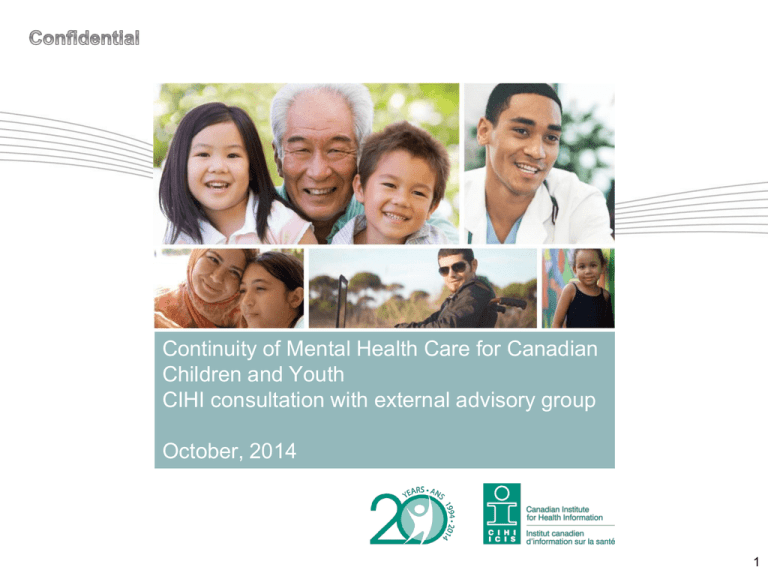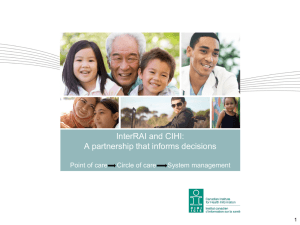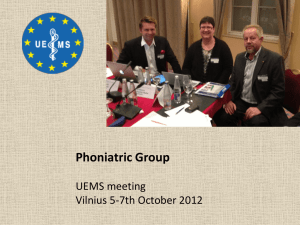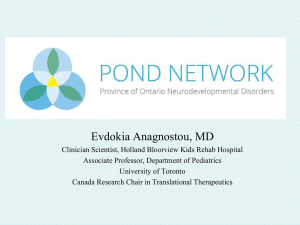Youth Mental Health intro – MHCC
advertisement

Continuity of Mental Health Care for Canadian Children and Youth CIHI consultation with external advisory group October, 2014 1 Presentation Objectives 1. Introduce CIHI’s children and youth mental health project 2. Present our policy and research questions 3. Present some preliminary CIHI data 4. Gather thoughts and reactions on the data and some input in terms of any potential gaps or additional ideas for analysis 2 Background • An estimated 10-20% of youth are affected by a mental health disorder– only 1 in 5 get the help they need. – Similarly, rates in U.S. and Australia reported as 13% and 14%, respectively. • In 2009, nearly one in four deaths among youth 15-19 was due to suicide. • Surpassed only by injuries, mental disorders in youth are ranked as the second highest hospital care expenditure in Canada. • In FY 2012-2013, 13% of inpatient stays among those aged 5-17 were for a mental disorder (using ICD-10-CA diagnosis codes). – This is compared to 10% of those aged 18-24, 6% aged 25-64 and 4% of those aged 65+ • Most are discharged back to the community – CIHI data is limited to emergency department and inpatient/acute care stays 3 Policy Question #1 How prevalent are mental disorders among children and youth in Canada? What are some common elements in child and youth mental health strategies or policies across the province? 4 How we intend to answer the question • Start with a discussion on state of child and youth mental health in Canada using summary statistics, for example: – Canadian Community Health Survey – Mental Health, 2012 (Statistics Canada) – National Longitudinal Study of Children and Youth, 1994-2009 (Statistics Canada) – Survey of Young Canadians, 2012 (Statistics Canada) • Compare provincial policies addressing mental health and substance abuse (commonalities: More resources, better trained staff, integrate mental health promotion in schools) • Discuss data availability / gaps 5 Policy Question #2 Who are the children and youth using Emergency and Acute Care services for mental disorders? 6 How we intend to answer the question • Discharge Abstract Database/Hospital Mental Health Database (FY 2006-07 to 2012-2013 – 2013-14 if possible) will provide pan-Canadian information on acute inpatient stays among youth 5-24. • National Ambulatory Care Reporting System (FY200607 to 2013-2014) will provide data on emergency department use among children and youth aged 5-24. • Ontario Mental Health Reporting System (FY2006-07 to 2012-2013) will provide information on youth using adult psychiatric beds in Ontario. 7 Overview of the population ED Visits Ages 5-17 Related to… Inpatient Stays Ages 18-24 Ages 5-17 Mental Health NonMental Health Mental Health NonMental Health Visits (% of all visits) 41,798 (4%) 1,126,859 (96 %) 67,865 (6%) 989,154 (94%) 14,920 (13%) 98,044 (86%) 14,922 (10%) 135,499 (90%) Unique Patients 31,252 727,083 46,008 546,919 11,596 78,428 10,841 112,179 Mental Health NonMental Health Ages 18-24 Mental Health NonMental Health Source: Discharge Abstract Database, CIHI, 2013. National Ambulatory Care Reporting System, CIHI, 2014. Note: Records with missing/invalid Health Care Numbers were removed for this analysis Defining the population • Restrict to ages 5-24 (5-17 = children and youth, 18-24 = youth in transition) • All ICD-10-CA codes in the following categories: Anxiety, Mood, Organic, Personality, Schizophrenic and other Psychotic, Substance Related, Unspecified Eating, Youth and Other Disorders. Exclusions • Newborns, children under the age of 5 and people >18 years of age • In-hospital deaths • ED visits ending as ‘Left without been seen’ as they do not have diagnosis information 8 The percent of hospitalizations for children and youth under 18 years of age for mental disorders has risen 5 percentage points over the last 8 years. 40 35 Percent 30 25 20 (N=14,920) 13 15 8 8 9 9 10 11 4 4 4 4 5 5 5 2006-07 2007-08 2008-09 2009-10 2010-11 2011-12 2012-13 (N=9,370) 10 5 0 Fiscal Year % of Inpatient Admissions Source: Discharge Abstract Database, CIHI, 2013. National Ambulatory Care Reporting System, CIHI, 2014. % of ED Visits 9 Characteristics of children and youth with ED visits for mental disorders, FY2013-14. Description Mental Health ED Visits (N=109,663) Non-Mental Health ED Visits (N=2,116,013) 77,260 1,274,002 3% 13% 25% 60% 53% 22% 20% 16% 43% 49% 21% 19% 20% 20% 19% 0.1% 80% 20% 19% 20% 21% 19% 0% 73% 1.6% 18% 0.8% 4% Unique Patients Age Group (%) 5-9 10-14 15-17 18-24 Female (%) Income Quintile (%) Low Low-Medium Medium Medium-High High Homeless (%) % Urban % Return to ED within 48 hours, all cause % Left Against Medical Advice % Admitted to Acute Top 3 Main Problems Females Males Females Males Anxiety disorders 32% Mood disorders 26% Substance-related 29% Anxiety disorders 26% Substance-related 21% Mood disorders 17% Injury, poisoning 26% Symptoms, signs, abnormal findings 18% Respiratory problems 13% Injury, poisoning 43% Symptoms, signs, abnormal findings 13% Respiratory problems 12% Source: National Ambulatory Care Reporting System, CIHI, 2014. 10 Characteristics of children and youth with hospitalizations for mental disorders, FY2012-13. Description Mental Health Discharges (N=27,500) Non-Mental Health Discharges (N=206,100) 20,800 1.3 71% 169,830 1.2 48% 1% 17% 36% 46% 16% 15% 16% 53% 57% 63% 23% 19% 19% 19% 18% 6 2% 74% 24% 20% 19% 19% 17% 2 <1% 71% Unique Patients Mean Number of Visits this year % Admitted from ED Age Group (%) 5-9 10-14 15-17 18-24 Female (%) Income Quintile (%) Low Low-Medium Medium Medium-High High Median LOS (Days) Homeless (%) % Urban Top 3 Main Problems Females Males Females Males Mood disorders – 37% Schizophrenia and Psychotic disorders – 28% Mood disorders – 25% Substance Use Disorders – 19% Complication of labour – 24% Appendicitis – 10% Maternal Care – 11% Specific procedures and health care – 5% Head injuries – 4% Other Mental Health Disorders – 30% Anxiety Disorders – 10% Appendicitis – 4% Source: Discharge Abstract Database, CIHI, 2013. 11 Percent of Discharges with Mental Health Diagnosis The rate of hospitalizations for children and youth with mental disorders varies by province (Fiscal Year 2012-2013). 100 90 80 70 60 50 40 30 20 10 0 Province Source: Discharge Abstract Database, CIHI, 2013. 12 Policy Question #3 Is there a repeating cycle of care for young patients with mental disorders? Are they frequent users of the health care system? 13 How we intend to answer the question • Two potential analyses are being considered: 1. Identify a patient cohort in acute care in 2006-07 and follow them forward to see their pattern of hospital utilization • i.e. a unique group of patients followed from a specified date, are these frequent users of the acute care/ED system? 2. Identify patient pathways by linking DAD and NACRS, and describing patients who are admitted into acute via the ED • i.e. building episodes, examine profile of patients admitted to acute through ED, looking at multiple visits in one year • Using external resources, identify community programs targeted at children and youth with recent discharges from inpatient care – Where is follow up occurring? With PHC provider? In school? 14 Children and youth with mental disorders are frequent users of hospital services. • In 2006-07, 7,418 children and youth between 5 and 17 had hospitalizations for mental disorders. – 18% had four or more visits for a mental disorder that year – 21% returned the following year, and of these 40% came back at least twice – In 2012, nearly half of these same patients were seen in the ED for a (the same?) mental disorder 15 ED Discharge Disposition, 2013-2014 109,663 ED visits for mental health disorders 18% are admitted Of those admitted: • 52% are female • 31% are between 15-17 • 30% were admitted with a mood disorder Admitted Discharged Home Transferred Other Source: National Ambulatory Care Reporting System, CIHI, 2013. 16 Other items to be discussed in report • Youth in transition 18-24 – Leaving high school, there is hesitancy to access adult services, but they may no longer qualify for youth services – may get lost in the cracks – According to CCHS – MH, these youth are at increased risk for mental illness and substance abuse – 10% of hospitalizations among 18-24 year olds are for mental disorders (includes substance abuse) • Other vulnerable populations (e.g. First Nations communities) • Encounters with justice system, corrections, family/social services 17 Policy Question #4 What is the dollar amount associated with children and youth seeking mental health services in emergency or acute care? Can we compare it or relate it to the cost of care in the community or cost of intervention in schools? Can we determine the current proportion of health dollars specifically allocated to mental health? 18 How we intend to answer the question • Using the Resource Intensity Weight and Cost per Weighted Case formula to determine cost associated with a stay in the hospital for a mental health diagnosis • Potentially use Canadian Patient Costing Database to get exact hospital stay costs for a subset of patients • National Physician Database to calculate how much physicians are billing for psychiatric services, therapy or counseling for children and youth under 20 • Grey literature addressing cost of mental health care in Canada, and what the long term cost would be if nothing is done for these youth today 19 Physician billing for Psychiatric services and counseling, NPDB, 2011-2012 • In 2011, nearly 5% of all physician payments in Canada was for psychotherapy / counseling services – Additional assessment and consultation services for mental health may have been billed, but they are not distinguishable from non-psychology/psychiatry assessments and consultations. • This varied from 8% in Alberta to <2% in Nova Scotia • Ontario paid just under $50,000,000 for psychotherapy/counseling services – 56% was paid to psychiatrists • Alberta paid just over $20,000,000 for psychotherapy/counseling services – 68% was paid to psychiatrists Source: National Physician Database, CIHI, 2012. DRAFT RESULTS – Do not circulate 20 Policy Question #5 What are the options for these patients at the end of their inpatient stay? What are the community treatment options? What does the evidence say is successful? 21 How we intend to answer this question • Environmental scanning / literature review – Discuss known effective interventions • Identify community data (e.g. Alberta Child Lab data), school board data (e.g. Toronto District School Board student survey) • A separate analysis will look at drugs prescribed to youth 15-24 in Western provinces that are typically indicated for mental disorders. 22 General Questions for External Advisory Group • Have we asked the right questions? • Are we missing any important questions? • Does the preliminary data resonate with you? • Can you share any initiatives you are aware of to address children and youth mental health that we can highlight? • Are you aware of data sources outside of CIHI or Statistics Canada that could strengthen our report? 23 Technical Questions for External Advisory Group • Inclusion of children and youth who arrive at the ED for self-harm or potential self-harm in absence of a mental health diagnosis? • Inclusion of a group who have “emotional state, suicidal ideation” as their diagnosis? • What age break downs are most informative? • We are considering excluding certain diagnoses such as developmental delay and organic disorders – would you agree or disagree? 24 Timelines and next steps • Consult with external advisors and incorporate feedback into methodology – Now-October, 2014 • Complete preliminary analyses and determine key findings – September – November, 2014 • Consult with external advisors and incorporate feedback, develop storyline – November-December, 2014 • Complete analyses and write-up, share externally, incorporate feedback – January-February, 2015 • Finalize and submit for translation and editing– March, 2015 • Public Release – Spring 2015 25 THANK YOU! Questions? 26









